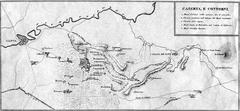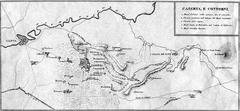Museum of the Royal Palace of Caserta: Complete Visiting Guide (2025)
Date: 03/07/2025
Introduction
The Royal Palace of Caserta (Reggia di Caserta), located in Caserta, Italy, is a monumental testament to 18th-century Baroque and Neoclassical architecture and remains one of the most significant royal residences in Europe. Commissioned in 1752 by Charles of Bourbon (King of Naples and Sicily), and designed by Luigi Vanvitelli, the palace was intended to rival Versailles, acting as both a royal residence and a symbol of Bourbon power and cultural advancement in southern Italy. Today, as a UNESCO World Heritage Site, the palace stands out for its architectural splendor, vast gardens, and the depth of its historical and artistic collections.
Whether you are a history enthusiast, art lover, or cultural traveler, this comprehensive guide covers everything you need to know for an enriching visit: from the history and highlights of the palace and museum collections, to detailed visitor information including opening hours, ticketing, accessibility, and nearby attractions.
Table of Contents
- Origins and Vision
- Construction and Historical Development
- Museum Collections and Cultural Role
- UNESCO World Heritage Status
- Architectural and Artistic Highlights
- Gardens and Park
- Modern Relevance and Restoration
- Visitor Information (Hours, Tickets, Accessibility)
- Travel Tips and Nearby Attractions
- FAQs
- Conclusion and Final Tips
- Sources and Official Links
Origins and Vision
Commissioned in 1752 by Charles of Bourbon, the Royal Palace of Caserta was envisioned as a statement of Bourbon prestige and Enlightenment ideals. Architect Luigi Vanvitelli’s plan included over 1,200 rooms across five floors, with dedicated spaces for royal apartments, administration, a library, and a theater. The palace was intended to be a self-sustaining complex, integrating political, cultural, and economic functions (reggiadicaserta.cultura.gov.it, theprouditalian.com).
Construction and Historical Development
While Charles of Bourbon initiated the project, it was his son Ferdinand IV who oversaw its completion after Charles abdicated to become King of Spain. Construction spanned several decades, with Vanvitelli’s son, Carlo, continuing the work after his father’s death in 1773. The palace complex included pioneering hydraulic systems, such as the Carolino Aqueduct, and the innovative San Leucio silk factory and workers’ village, further embodying Enlightenment values (reggiadicaserta.cultura.gov.it).
Museum Collections and Cultural Role
The Museum of the Royal Palace of Caserta preserves a remarkable array of artifacts reflecting the region’s deep history and the palace’s royal legacy. Collection highlights include:
- Ancient Artifacts: Mater Matuta statues and Norman-Swabian parchments illustrate the area’s ancient and medieval past.
- Mommsen Lapidary: Inscribed stones and epigraphs provide insight into regional governance and culture.
- Royal Apartments and State Rooms: Lavishly decorated with frescoes, stuccoes, and period furnishings, these rooms offer a window into the ceremonial and private life of the Bourbon court.
- Contemporary Art: The Terrae Motus collection, created in response to the 1980 Irpinia earthquake, features modern works by international artists. (theprouditalian.com)
UNESCO World Heritage Status
In 1997, the Royal Palace of Caserta, together with the Carolino Aqueduct and the San Leucio complex, was listed as a UNESCO World Heritage Site. UNESCO recognized the palace as a unique integration of architecture, landscape design, engineering, and sculpture, and as a culminating achievement of Baroque art (reggiadicaserta.cultura.gov.it, historytools.org).
Architectural and Artistic Highlights
Grand Staircase and Main Halls
The palace entrance features the Grand Staircase of Honor, with 116 marble steps and statues representing the four cardinal virtues, illuminated by a grand dome (museumsexplorer.com). The Throne Room, Hall of the Guards, and Palatine Chapel are among the most notable interiors, adorned with frescoes, gilded stuccoes, and exquisite furnishings (secretitaly.it).
Decorative Arts and Collections
Frescoes by Girolamo Starace and Domenico Mondo depict mythological and historical scenes. The palace houses tapestries, rare manuscripts in the Palatine Library, as well as decorative objects like Sèvres porcelain (secretitaly.it).
Royal Theatre
The Royal Theatre, modeled after Naples’ Teatro San Carlo, is an intimate, richly decorated venue for performances and court entertainment (secretitaly.it).
Gardens and Park
Spanning over 120 hectares, the gardens are a masterful blend of French, Italian, and English landscaping traditions. The central axis, lined with monumental fountains and cascades, culminates at the Fountain of Diana and Actaeon. The English Garden, commissioned by Queen Maria Carolina, is among the oldest in Europe, featuring exotic plants and romantic landscapes (eupedia.com).
Electric shuttles, golf carts, and bicycles are available for exploring the park’s vast expanse (eupedia.com).
Modern Relevance and Restoration
Restoration projects have revitalized the palace, notably reopening the west wing and Graefer Greenhouses. The palace remains a vibrant cultural hub, hosting exhibitions, concerts, and special events (finestresullarte.info). Its grand interiors have served as filming locations for international movies, such as “Star Wars” and “Mission Impossible,” enhancing its global cultural profile (historytools.org).
Visitor Information (Hours, Tickets, Accessibility)
Opening Hours
- Royal Apartments: 8:30 am – 7:30 pm (last entry 6:15 pm), closed Tuesdays.
- Gardens & Park: Opens at 8:30 am; closing times vary by season.
- Court Theatre: Weekends 10:00 am – 1:00 pm (may close for special events).
- Palatine Chapel: 8:30 am – 6:15 pm (Sunday Mass at noon).
(reggiadicaserta.cultura.gov.it, reggia-di-caserta.com)
Tickets
- Standard Ticket: €19 (includes palace, park, gardens, Court Theatre, and English Garden).
- Discounts: Campania Artecard and free entry dates available.
- Where to Buy: Online (Ticketone) or at the palace ticket office; advance purchase recommended.
Accessibility
- Priority entrance, elevators, ramps, accessible restrooms.
- Minibuses, golf carts, and bikes for easier navigation.
- Free luggage storage and child facilities available.
Travel Tips and Nearby Attractions
- Getting There: Caserta train station is opposite the palace (frequent trains from Naples and Rome). Paid parking is available under the main square.
- Best Time to Visit: Spring and early autumn offer pleasant weather and fewer crowds; early mornings are ideal.
- Nearby Attractions: Visit the San Leucio Silk Museum and Caserta Vecchia, or walk the ancient aqueduct route (eupedia.com).
FAQs
Q: Are guided tours available?
A: Yes, in multiple languages; book ahead for the best experience.
Q: Is the palace wheelchair accessible?
A: Most areas are accessible; shuttle services available for the gardens.
Q: Can I bring pets?
A: Pets are not allowed inside the palace or gardens.
Q: Is photography allowed?
A: Yes, but flash and tripods are restricted.
Q: How long should I plan for a visit?
A: At least 3 hours; a half-day recommended to enjoy both palace and gardens.
Conclusion and Final Tips
The Royal Palace of Caserta is a breathtaking testament to Italy’s royal, architectural, and artistic legacy. With its vast collections, beautiful gardens, and vibrant cultural programming, it offers an unforgettable experience for visitors of all interests. Plan your visit with care—considering opening hours, ticket options, and accessibility—so you can immerse yourself fully in the grandeur and history of this iconic site. For an enriched experience, use the Audiala app for audio guides and real-time updates, and explore related historical sites in the Caserta region.
Sources and Official Links
- Official Royal Palace of Caserta website
- The Proud Italian
- Museumsexplorer
- Secret Italy
- History Tools
- Finestre sull’Arte
- Eupedia
- Reggia di Caserta



